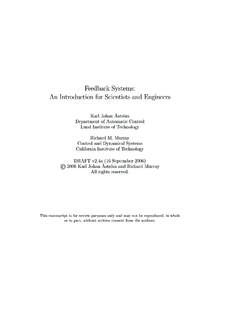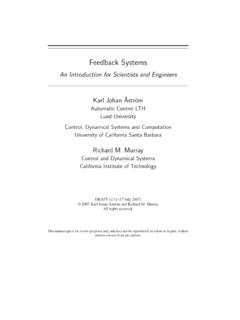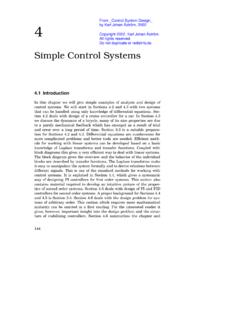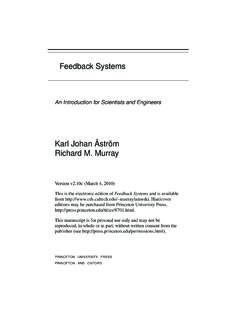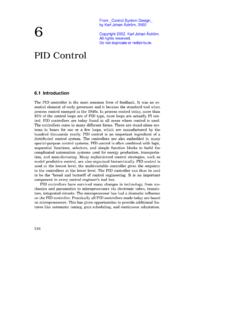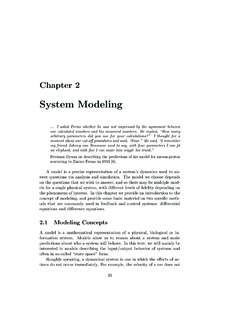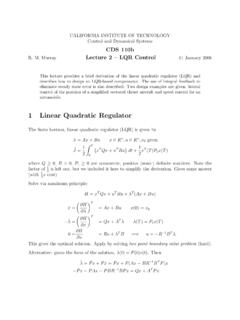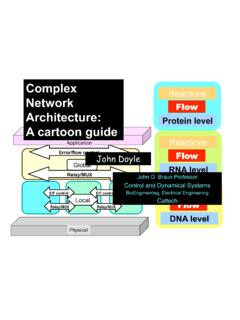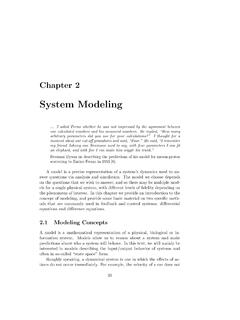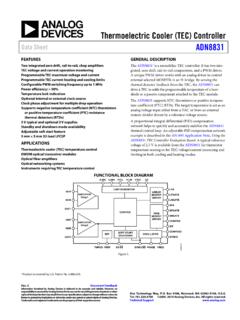Transcription of PID Control
1 Chapter 10 PID ControlBased on a survey of over eleven thousand controllers in the refining, chemi-cals and pulp and paper industries, 97% of regulatory controllers utilize Honeywell, 2000, see [DM02].PID Control is by far the most common way of using feedback in naturaland man-made systems. PID controllers are commonly used in industryand a large factory may have thousands of them, in instruments and lab-oratory equipment. In engineering applications the controllers appear inmany different forms: as a stand alone controller, as part of hierarchical,distributed Control systems, or built into embedded components. Most con-trollers do not use derivative action. In this chapter we discuss the basicideas of PID Control and the methods for choosing the parameters of thecontrollers.
2 Many aspects of Control can be understood based on linearanalysis. However, there is one nonlinear effect, that has tobe considered inmost Control systems namely that actuators saturate. In combinations withcontrollers having integral actions saturations give riseto an effect calledintegral windup. This phenomenon that occurs in practically all controlsystems will be discussed in depth for PID controllers. Methods to avoidwindup will also be presented. Finally we will also discuss implementationof PID controllers, similar methods can be used to implementmany 10. PID Control PresentFuturePasttt+TdErrorTimeFigure : A PID controller takes Control action based on past, present andprediction of future Control The ControllerThe ideal version of the PID controller is given by the formulau(t) =kpe(t) +ki t0e( )d +kddedt,( )whereuis the Control signal andeis the Control error (e=r y).
3 Thereference value,r, is also called thesetpoint. The Control signal is thus asum of three terms: a proportional term that is proportionalto the error, anintegral term that is proportional to the integral of the error, and a derivativeterm that is proportional to the derivative of the error. Thecontrollerparameters are proportional gainkp, integral gainkiand derivative controller can also be parameterized asu(t) =kp(e(t) +1 Tit 0e( )d +Tdde(t)dt),( )whereTiis the integral time constant andTdthe derivative time proportional part acts on the present value of the error,the integralrepresents an average of past errors and the derivative can be interpreted asa prediction of future errors based on linear extrapolation, as illustrated inFigure Note that the Control signaluis formed entirely from the errore, there is no feedforward term (which would correspond tokrrin the statefeedback case).
4 In Section we will introduce a modification which alsouses begin our analysis by considering pure proportional feedback. Fig-ure shows the responses of the output to a unit step in the THE (a)(b)(c)Figure : Responses to step changes in the command signal for a proportionalcontroller (left), PI controller (center) and PID controller (right). The processhas the transfer functionP(s) = 1/(s+ 1)3, the proportional controller (left) hadparameterskp= 1 (dashed), 2 and 5 (dash-dotted), the PI controller has parameterskp= 1,ki= 0 (dashed), , and 1 (dash-dotted), and the PID controller hasparameters arekp= ,ki= andkd= 0 (dashed), 1, 2, 3 and 4 (dash-dotted).signal for a system with pure proportional Control at different gain the absence of a feedforward term, the output never reaches the referenceand hence we are left with non-zero steady state error.
5 Letting the pro-cess and the controller have transfer functionsP(s) andC(s), the transferfunction from reference to output isGyr=P C1 +P C.( )The zero frequency gain with proportional controlC(s) =kpisGyr(0) =P(0)kp1 +P(0)kpand thus the steady state error for a unit step is 1 Gyr(0) = 1/(1+kpP(0)).For the system in Figure with gainskp= 1, 2 and 5, the steady stateerror is , and The error decreases with increasing gain, but thesystem also becomes more oscillatory. Notice in the figure that the initialvalue of the Control signal equals the controller 10. PID Control Keu11 +sTiuy1 11+sT (a)(b)Figure : Implementation of integral action (left) and derivative action (right)by combining simple avoid having a steady state error, the proportional controller can bechanged tou(t) =kpe(t) +ud,( )whereudis a feedforward term that is adjusted to give the desired steadystate value.
6 If we chooseud=r/P(0) =krr, then the output will be exactlyequal to the reference value, as it was in the state space case. However,this requires exact knowledge of the process dynamics, which is usually notavailable. In early controllers the termud, which was also called the reset,was adjusted manually to obtain the desired steady we saw in Sections and , integral action guaranteesthat theprocess output agrees with the reference in steady state andprovides analternative to including a feedforward term. To see the effect of integralaction in the frequency domain, we consider a proportional-integral (PI)controller, which has a transfer functionC(s) =kpe+ see that the controller has infinite zero frequency gain (C(0) = ) andit then follows from equation ( ) thatGyr(0) = 1, which implies thatthere is no steady-state action can also be viewed as a method for generatingthe feed-forward termudin the proportional controller ( ) automatically.
7 Analternative way to represent this action is shown in Figure , where thelow pass part of the Control action of a proportional controller is filtered andfeed back with positive gain. This implementation, calledautomatic reset,was one of the early inventions of integral Control . Integral action is oftenrealized in this way in biological THE CONTROLLER305 The transfer function of the system in Figure is obtained by looptracing: assuming exponential signals, we haveu=kpe+11 +sTu,and solving forugivesu=kp1 +sTsTe=kp+kpsT,which is the transfer function for a PI properties of integral action are illustrated in Theproportional gain is constant,kp= 1, and the integral gains areki= 0, , and 1. The caseki= 0 corresponds to pure proportional Control , with asteady state error of 50%.
8 The steady state error is removed when integralgain action is used. The response creeps slowly towards the reference forsmall values ofki, but faster for larger integral gains, but the system alsobecomes more now return to the general PID controller and consider the use ofthe derivative term,kd. Recall that the original motivation for derivativefeedback was to provide predictive action. The input-outputrelation of acontroller with proportional and derivative action isu=kpe+kddedt=k(e+Tddedt),whereTd=kd/kp is the derivative time constant. The action of a controllerwith proportional and derivative action can be interpretedas if the controlis made proportional to thepredictedprocess output, where the predictionis made by extrapolating the errorTdtime units into the future using thetangent to the error curve (see Figure ).
9 Derivative action can also be implemented by taking the difference be-tween the signal and its low-pass filtered version as shown in Figure transfer function for the system isC(s) =(1 11 +sT)=sT1 +sTU(s).The system thus has the transfer functionG(s) =sT /(1 +sT), which ap-proximates a derivative for low frequencies. Notice that this implementationgives filtering illustrates the behavior of a system with a PID controller:the system is oscillatory when no derivative action is used and it becomes306 CHAPTER 10. PID Control more damped as derivative gain is increased. A comparison ofthe systemswith P, PI and PID Control in Figure shows that the steady-state erroris removed by introducing integral action and that the response speed canbe improved by introducing derivative TuningUsers of Control systems are frequently faced with the task of adjustingthe controller parameters to obtain a desired behavior.
10 There are manydifferent ways to do this. One way to do this is to go through thesteps ofmodeling and Control design. Since the PID controller has sofew parametersa number of special empirical methods have also been developed. A simpleidea is to connect a controller, increase the gain until the the system startsto oscillate, and then reduce the gains by an appropriate factor. Anotheris to measure some features of the open loop response and to determinecontroller parameters based on these features. We will present the Ziegler-Nichols methods which are the most celebrated tuning TuningZiegler and Nichols develped two techniques for controllertuning in the1940s. The idea was to tune the controller based on the following idea: Makea simple experiment, extract some features of process dynamics from theexperimental data, and determine controller parameters from the method is based on direct adjustment of the controller controller is connected to the process, integral and derivative gain areset to zero and the proportional gain is increased until the system startsto oscillate.
